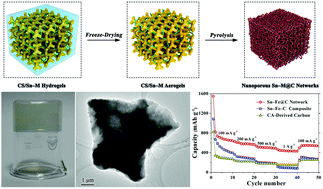Pyrolysis of cyano-bridged hetero-metallic aerogels: a general route to immobilize Sn–M (M = Fe, Ni) alloys within a carbon matrix for stable and fast lithium storage†
Abstract
The practical application of Sn–M (M = Fe, Ni, Co, and Cu) alloys, a promising anodic category for lithium-ion batteries, is hindered primarily by their huge volume change upon cycling. Immobilization of Sn–M alloys within carbon matrices has proven to be effective to improve their cycling stability, but the traditional pyrolysis of separate Sn, M, and C precursors often leads to uneven distribution of the three components in Sn–M–C ternary anodes. Herein, we report a facile and general aerogel-derived pyrolysis route to realize homogeneous embedding of uniformly-sized Sn–M alloy nanocrystals, within a nanoporous carbon matrix, using cyano-bridged hetero-metallic (Sn–M) aerogels hybridized with carbon sources as precursors. Using the optimized citric acid (CA) as a carbon source, the formations of nanoporous Sn–Fe@C and Sn–Ni@C networks have been illustrated as examples through pyrolyzing CA/Sn–Fe and CA/Sn–Ni aerogels, respectively. By virtue of their compositional/structural superiorities toward lithium storage, the as-prepared Sn–Fe@C and Sn–Ni@C networks manifest higher capacities, enhanced cycling stability, and improved rate capability compared to the Sn–M–C composites and carbon samples derived from bare aerogels and CA precursors, respectively. Specifically, the Sn–Fe@C network manifests a high reversible capacity of 441.6 mA h g−1 after 100 cycles at 100 mA g−1 and an average capacity of 438.6 mA h g−1 at 1 A g−1. This work shows a new guideline for designing highly-uniform Sn–M–C, Sb–M–C, and Bi–M–C ternary anodes for boosting energy storage.



 Please wait while we load your content...
Please wait while we load your content...